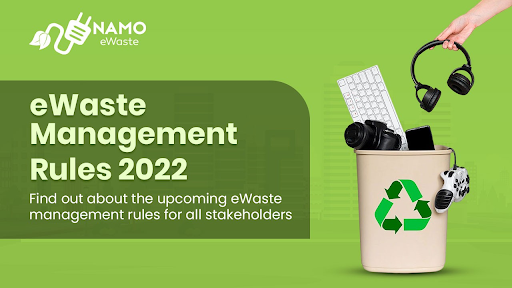The Ministry of Environment, Forest and Climate change has made some changes to their rules on how to handle e-waste. Every company which handles any type of unwanted electronic product or equipment needs to be aware of these new rules before they begin operations. These rules will come into effect from the 1st of April 2023.
Every manufacturer, producer refurbisher, dismantler and recycler involved in manufacture, sale, transfer, purchase, refurbishing, dismantling or processing of e-waste or electrical and electronic equipment including their components, consumables parts and spares which make the product operational shall formulate to comply with these rules.
However this rule shall not be applicable to waste batteries as covered under the Battery Waste Management Rules, 2022, packaging plastics as covered under the Plastic Waste Management Rules, 2016, micro enterprise as defined in the Micro, Small and Medium Enterprises Development Act, 2006 and radio-active wastes as covered under the provisions of the Atomic Energy Act, 1962.
Extended Producer Responsibility Framework
The entities shall register on the portal in any of the following category, namely:
(a) Manufacturer;
(b) Producer;
(c) Refurbisher
(d) Recycler
Responsibilities of the manufacturer:
All manufacturers shall have to-
(1) Register on the portal;
(2) Collect e-waste generated during the manufacture of any electrical and electronic equipment and ensure its recycling or disposal;
(3) File annual and quarterly returns in the laid down form on the portal on or before end of the month succeeding the quarter or year, as the case may be, to which the return relates.
Responsibilities of the producer:
The producers of electrical and electronic equipment listed in Schedule I shall be responsible for –
(1) Registration on the portal;
(2) Obtaining and implementing extended producer responsibility targets as per Schedule-III and Schedule-IV through the portal: Provided that the producer having extended producer responsibility plan under the provisions of the erstwhile E-Waste (Management) Rules, 2016 shall migrate under these rules as per the procedure laid down by the Central Pollution Control Board with approval of Steering Committee;
(3) Creating awareness through media, publications, advertisements, posters or by any other means of communication;
(4) File annual and quarterly returns in the laid down form on the portal on or before the end of the month succeeding the quarter or year, as the case may be, to which the return relates.
Responsibilities of the refurbished:
All refurbishers shall have to-
(1) Register on the portal;
(2) Collect e-waste generated during the process of refurbishing and hand over the waste to registered recycler and upload information on the portal;
(3) Ensure that the refurbished equipment shall be as per Compulsory Registration Scheme of the Ministry of Electronics and Information Technology and Standards of Bureau of Indian Standards framed for this purpose;
(4) File annual and quarterly returns in the laid down form on the portal on or before the end of the month succeeding the quarter or year, as the case may be, to which the return relates.
Responsibilities of bulk consumer:
Bulk consumers of electrical and electronic equipment listed in Schedule I shall ensure that e-waste generated by them shall be handed over only to the registered producer, refurbisher or recycler.
Responsibilities of the recycler:
All recyclers shall have to-
(1) Register on the portal;
(2) Ensure that the facility and recycling processes are in accordance with the standards or guidelines laid down by the Central Pollution Control Board in this regard from time to time;
(3) Ensure that the fractions or material not recycled in its facility is sent to the respective registered recyclers;
(4)Ensure that residue generated during recycling process is disposed of in an authorised treatment storage disposal facility;
(5) Maintain record of e-waste collected, dismantled, recycled and sent to registered recycler on the portal and make available all records for verification or audit as and when required;
Procedure for storage of e-Waste:
The Central Pollution Control Board shall ensure that the e-waste is handled, stored and disposed of in accordance with the guidelines or rules framed by it.
Every manufacturer, producer, refurbisher and recycler may store the e-waste for a period not exceeding one hundred and eighty days and shall maintain a record of sale, transfer and storage of e-wastes and make these records available for inspection and the storage of the e-waste shall be done as per the applicable rules or guidelines for the time being in force:
Provided that the Central Pollution Control Board may extend the said period up to three hundred and sixty-five days in case the e-waste needs to be specifically stored for development of a process for its recycling or reuse.
Hazardous substances in Electronic equipment
The reduction in the use of hazardous substances in the manufacture of electrical and electronic equipment and their components, or components or parts or spares is a key objective of this directive.
(1) Every producer of electrical and electronic equipment and their components or consumables or parts or spares listed in Schedule I shall ensure that, new electrical and electronic equipment and their components or consumables or parts or spares do not contain Lead, Mercury, Cadmium, Hexavalent Chromium, polybrominated biphenyls and polybrominated diphenyl ethers beyond a maximum concentration value of 0.1 percent by weight in homogeneous materials for lead, mercury, hexavalent chromium, polybrominated biphenyls and polybrominated diphenyl ethers and of 0.01 per cent by weight in homogeneous materials for cadmium.
(2) Components or consumables or parts or spares required for the electrical and electronic equipment placed in the market prior to the 1st May, 2014 may be exempted from the provisions of sub-rule (1) provided reduction of hazardous substances compliant parts and spares are not available.
(3) The applications listed in Schedule-II shall be exempted from provisions of sub- rule (1).
(4) Every producer of applications listed in Schedule-II shall ensure that the limits of hazardous substances as given in Schedule-II are to be complied.
(5) Every producer shall provide the detailed information on the constituents of the equipment and their components or consumables or parts or spares along with a declaration of conformance to the reduction of hazardous substances provisions in the product user documentation.
(6) Imports or placement in the market for new electrical and electronic equipment shall be permitted only for those which are compliant to provisions of sub-rules (1) and (4).
(7) Manufacture and supply of electrical and electronic equipment used for defence and other similar strategic applications shall be excluded from provisions of sub- rule (1).
(8) Every producer shall provide information on the compliance of the provisions of sub-rule (1) and this information shall be in terms of self-declaration.
(9) Manufacturer shall use the technology or methods so as to make the end product recyclable;
(10) Manufacturer shall ensure that components or parts made by different manufacturers are compatible with each other so as to reduce the quantity of e-waste.
(11) The Central Pollution Control Board shall conduct random sampling of electrical and electronic equipment placed on the market to monitor and verify the compliance of reduction of hazardous substances provisions and the cost for sample and testing shall be borne by the producer and the random sampling shall be as per the guidelines laid down by the Central Pollution Control Board in this regard.
(12) If the product does not comply with reduction of hazardous substances provisions, the producer shall take corrective measures to bring the product into compliance and withdraw or recall the product from the market, within a reasonable period as per the guidelines laid down by the Central Pollution Control Board in this regard.
(13) The Central Pollution Control Board shall lay down the methods for sampling and analysis of hazardous substances as listed in sub-rule (1) with respect to the items listed in Schedule-I and Schedule II and also enlist the labs for the said purpose.
Taking everything into consideration
Changing rules and regulations is a great initiative by the Indian government. By doing so, we will be able to reduce the amount of eWaste generated in India in the future. As a result, new producers and recyclers will also be able to benefit from it, which is good for the environment.


